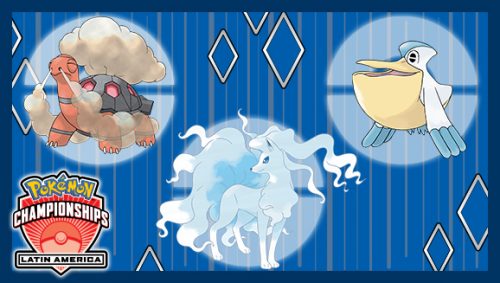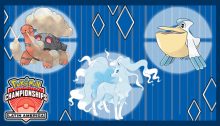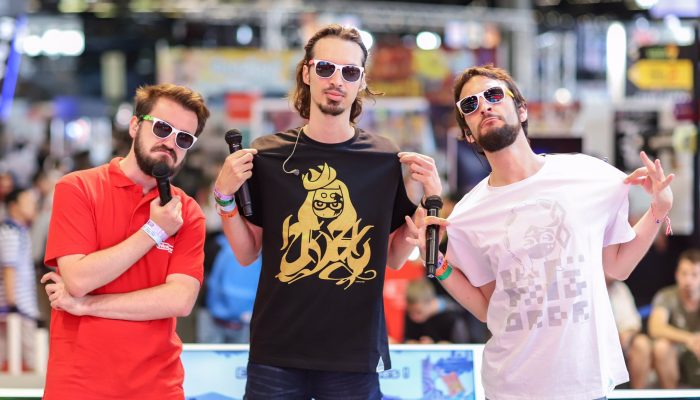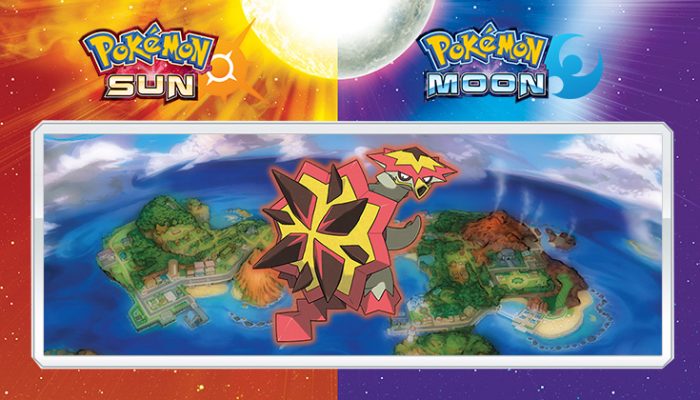 The biggest surprise in the Masters Division tournament was undoubtedly that five different Pokémon with weather-changing Abilities made it to the top cut.
The biggest surprise in the Masters Division tournament was undoubtedly that five different Pokémon with weather-changing Abilities made it to the top cut.
☆ NintendObs Weekly – Monday, May 1, 2017 – Sunday, May 7, 2017.

Unraveling the VGC Latin American International Championships
Battles have concluded in São Paulo, Brazil, and the third of four 2017 Pokémon International Championships is in the books. With cash prizes, travel awards, and enough Championship Points to instantly qualify for the Pokémon World Championships on the line, Trainers brought their best strategies to Brazil.
The ways in which Trainers’ bests manifested was very different in the Masters Division than in the Junior and Senior Divisions, both in terms of the Pokémon selected and which Trainers earned the big prizes, compared to previous events. Read on to see which strategies and Trainers came out on top in all three age divisions.
Pokémon Prodigies
The Junior Division and Senior Division competitions seemed to run in parallel. The top-performing players in both divisions were largely familiar faces from previous International Championships, with both finals including Trainers hoping for back-to-back victories. And the Pokémon selected in both the Senior Division and the Junior Division tended toward more conventional strategies, with the top players in both age categories sticking mostly to established Pokémon groupings.
The Junior Division top cut in Brazil featured only four players, but each of them was extremely accomplished. All four players also made it to the top cut of the recent Oceania International Championships, including the local Champion, Nicholas Kan. Singapore’s Corey Elliot Yuen faced Nicholas in the finals this time, and again Nicholas stood victorious after a back-and-forth three game series using a team he’s grown familiar with.
American Carson St. Denis had his own opportunity to win back-to-back International Championships in the Senior Division. But the path to Pokémon immortality is never easy, and Carson couldn’t have been matched with a more challenging final opponent. On the other side of the field was German Jan Tillmann, the winner of the European International Championships. Carson survived this clash of Champions, leaving us with repeat Champions in both the Junior and Senior Divisions. Unlike Nicholas, Carson made some impactful changes to his team from Oceania—he replaced his Kartana, Gigalith, and Porygon2 with a throwback to Celesteela, Garchomp, and the trending Snorlax.
Masters Division Tournament Tales
Unlike the younger age divisions, the Masters Division saw significant shake-up at its top tables. And the final battles featured some unexpected strategies, too.
Trainers had their poise tested in São Paulo as more than one loss would almost guarantee their elimination. There were 186 Trainers competing in the Masters Division—fewer than the 227 necessary to play two days of Swiss rounds—so eight players moved on to the top cut after eight Swiss rounds. Some top performers from previous International Championships were among the first to be eliminated from contention. Oceania International Champion Zoe Lou and a pair of players who made top cut in the first two Internationals, Ben Kyriakou and Nico Davide Cognetta, were eliminated after taking two losses during the first few rounds.
The group that did make the top cut included both heroes from tournaments past and some players newly making names for themselves on an international stage. Tommy Cooleen made it to the top cut for the third International Championship event in a row, proving himself to be the most consistent player over those three competitions. And as with both of the previous Internationals, he used a team featuring Pelipper and Golduck. Despite his success, he remains the only player to make the top cut in a Masters Division International Championship event with either Pokémon.
Tommy was defeated in the quarterfinals once again, however, as was European International Championships top cut competitor William Tansley, 2016 World Championships semifinalist Markus Stadter, and Ian McLaughlin, who was the top player after Swiss rounds concluded. All three of the latter participants included some surprises on their teams. Markus continued his recent trend of using teams including Alolan Persian and Snorlax, reaffirming that Parting Shot-based tactics can succeed even at the highest level. William brought Togedemaru to its first Internationals top cut appearance, while Ian surprised with a terrifying offensive team combining three Ultra Beasts and Smeargle.
The remaining Trainers from the Latin American rating zone—Carlos Ventura of Peru and Gabriel Agati of Brazil—were both defeated in the semifinals. Gabriel’s team of Tapu Bulu, Arcanine, Salamence, Politoed, Alolan Muk, and Porygon2 was particularly interesting. His strategy was very similar to the team Wolfe Glick used in the very first International Championships, and with Gabriel’s updates the team still proved successful months after its initial appearance.
The final showdown was between American Ashton Cox and Spaniard Javier Señorena. Weather-based teams had been considered second-tier strategies by most top-ranked players, but the finals shook that perception. Ashton’s team included both Torkoal and Lilligant to make the most of the Drought Ability, while Javier brought Alolan Ninetales and its combination of the Snow Warning Ability and the move Aurora Veil. Ultimately, Ashton came out on top and become the first player to win a video game Masters Division International Championship in a foreign rating zone.
Wacky Weather Wiles
The biggest surprise in the Masters Division tournament was undoubtedly that five different Pokémon with weather-changing Abilities made it to the top cut. Only Gigalith and its Sand Stream Ability had been considered an elite contender by most Trainers before the tournament. But the results in São Paulo make clear that each weather-based strategy is potent enough to deserve further consideration.
Ashton Cox and his team were among the most confounding to match up with in São Paulo. The pairing of Torkoal and Lilligant—a duo most Trainers probably weren’t expecting—combined with a number of other Pokémon that are very tricky to play against, made for a devastating mix. Lilligant’s Chlorophyll Ability and the naturally speedy Pheromosa gave Ashton two of the quickest Pokémon in most matches. And with Torkoal and Snorlax on his team, he often had the two slowest Pokémon as well, creating extreme risk for opponents aiming to gain a speed advantage using Trick Room. Finishing the team with Mimikyu and Tapu Lele gave Ashton six Pokémon that normally require immediate action from his opponents, making it difficult to focus on any one of his strategies.
Two Trainers included Pokémon with the Drizzle Ability on their teams, both executing different strategies. Tommy Cooleen‘s pairing of Pelipper and Golduck gave his team a formidable offensive duo similar to Torkoal and Lilligant. Semifinalist Gabriel Agati’s team was much more defensive—Politoed’s Drizzle was used to reduce the damage of incoming attacks and negate opposing weather more so than to enhance its own offense. One key Pokémon both Trainers had in common was Alolan Muk. The Sludge Pokémon proved to be one of the most dominant defensive Pokémon in São Paulo overall, and it combined particularly well with the challenges these teams caused for the otherwise problematic Arcanine and Garchomp.
Runner-up Javier Señorena was the tournament’s premier Alolan Ninetales player, but his team is more reminiscent of how Trainers build around Gigalith and Politoed than Pelipper and Torkoal. While we’ve seen some players pair Ninetales with an Alolan Sandslash that has the Slush Rush Ability, the Ninetales on Javier’s team performs a different function. Ninetales’s Ice-type attacks help mitigate opposing Garchomp for Muk, and its Aurora Veil further increases the defensive power of an already sturdy team. Weather strategies for one Pokémon are normally more reliable than pairings, but even solo Ninetales struggles against other weather teams because of Blizzard’s reduced accuracy outside of the hail weather condition and because Aurora Veil fails completely without it.
Ninetales’s weaknesses stem from a key element of weather-based combat: on the first turn of battle, quicker Pokémon’s Abilities activate first. Ninetales’s high Speed is a great asset against Garchomp, but leading with Ninetales against a team featuring a different weather is precarious. Matchups with the stout Gigalith and Torkoal become particularly difficult because Ninetales normally won’t be able to get the hail weather condition up early or for long. Pokémon reliant on having the correct weather up because of Abilities like Swift Swim and Slush Rush can similarly be caught out in the cold when both sides are trying to change the weather.
If the event in São Paulo improves the perception of weather teams, look for Trainers to trend toward the slower weather-summoning Pokémon as a countermeasure for opposing weather teams rather than adopting speedy—and thus risky—weather strategies of their own.
Parting Shots
The prevalence of the Intimidate Ability has been a major factor at every major event this year, and the Latin American International Championships were no exception. Arcanine comfortably maintained its place as the most popular Pokémon in the format, appearing on six of the eight Masters Division top cut teams. The most interesting adaptation to Intimidate was found on the team of Senior Division runner-up Jan Tillmann. His Braviary had the Defiant Ability, which causes it to gain Attack instead of lose it when intimidated. The combination of Defiant, an immunity to Ground-type attacks, and access to the Tailwind move make for an enticing combination. Perhaps more Trainers in all age divisions will give Braviary a try after Jan’s success.
The only Pokémon the two Masters Division finalists had in common was Tapu Lele, which was also the only one shared by the winners of the previous two Masters Division Internationals. With all four Tapu making the Masters Division top cut in São Paulo, one takeaway from this tournament is that any of the Tapu could help anchor a winning team. But Tapu Lele’s recent success is starting to set it apart as one of the defining Pokémon of the 2017 Video Game Championships. São Paulo was also the first Internationals where Tapu Koko did not come out on top in the Masters Division, perhaps a product of each weather archetype having a way to trouble Melemele’s guardian.
We previewed the combination of Mimikyu and Snorlax before the event through Gavin Michaels’s team, but Ashton Cox’s version of the duo showed off a different take. Both Trainers used Snorlax as a difficult-to-knock-out Pokémon that demanded prioritization because of Belly Drum. But while Gavin protected Snorlax by redirecting attacks using Mimikyu’s Z-Destiny Bond, Ashton taught his Mimikyu Psych Up instead. It allows Mimikyu to copy the boost from Snorlax’s Belly Drum, and it even works while Snorlax is using Protect. Both takes on this pairing can dominate matches, and the threat of each strategy makes the other more dangerous—if you don’t know which version of the duo you’re about to face, it’s more difficult to react accordingly.
The final International Championships will take place from June 30–July 2, 2017, in Indianapolis, IN. For the inaugural North American International Championships, Trainers will return to the site of six of the last seven US National Championships for their final chance to earn enough Championship Points to qualify for the 2017 Pokémon World Championships. Stay tuned to Pokemon.com/Strategy for coverage and analysis of both the Pokémon TCG and video game tournaments.
Source: Pokémon.
At NintendObserver, the comments are on Discord.
Click on Community to learn more. 🙂
…
And if you’ve already got yours, click on Pokémon Sun & Moon for everything you need to know about the games. 😀



